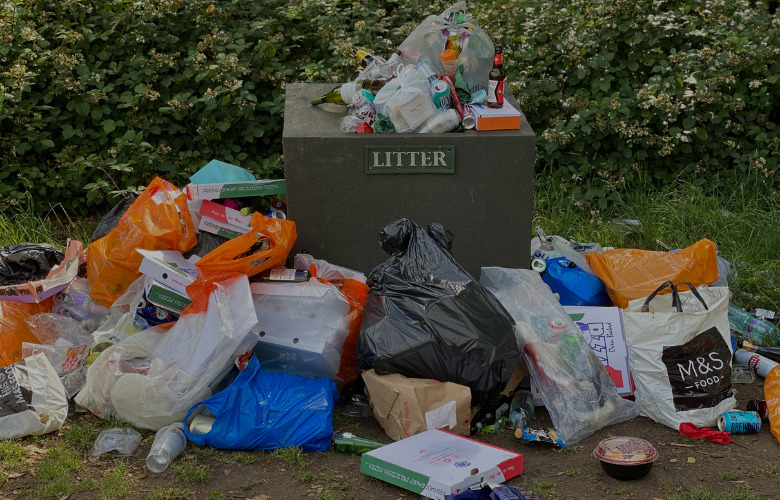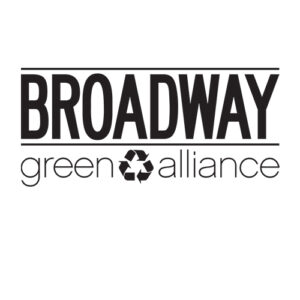
There are many ways your production can cut down on waste, promote recycling and composting programs, and find ways to reuse items.
The best way to cut down your waste stream and minimize waste costs is to reduce the amount of materials you need to discard. Minimize waste generation by avoiding unnecessary packaging and paper use, reducing the amount of disposable products your production uses, and reusing materials.
For example, by reusing signs and banners, your show can avoid unnecessary printing costs, waste hauling costs, and the environmental impacts of printing. Consider designing banners so that they can be easily reused, by avoiding listing dates or ensuring that the portions listing dates can be readily and cheaply altered. Also consider producing signs from more durable materials, and ensure that these materials are ultimately recyclable. While they may cost more initially, they can save money in the long run. Try to avoid purchasing banners made from PVC (vinyl), which is associated with toxic emissions in production, use, and disposal.
Reducing paper use can also considerably cut down on waste and purchasing costs. See the Paper Use Reduction section for more information.
Instead of providing bottled water backstage, supply reusable bottles and water fountains or filtered tap water stations for cast and crew. At minimum, supply water from bulk containers like water coolers that use refillable water jugs. Consider branding bottles and coffee mugs with your show logo and giving them out during the first rehearsal. Make sure that cast and crew know where bottles and mugs are stored and where they can be washed. Consider providing labels to help staff identify their items. Discourage staff from purchasing or requesting single-serving bottles of water whenever possible.
For information on water filters, visit the website of the National Sanitation Foundation International, which provides listings of NSF Certified Drinking Water Treatment Units.
Work with venue staff to learn about what items are recycled in the building and how they should be sorted. Explain mandatory recycling policies to all cast and crew. Clearly mark recycling bins with pictures of the items they accept, make sure they are in convenient locations, and point them out during initial backstage tours. If the venue has a composting program, explain mandatory composting policies to all cast and crew, identify clearly marked composting bins, and ensure they are used correctly by production staff members.
Consider using NRDC’s Paper Recycling Signage (PDF) as a model for your paper recycling signs.
Many shows have instituted backstage collection programs for a variety of items that are collected by the BGA for reuse or recycling, such as corks, printer cartridges, bottle caps, batteries, textiles, food packaging, and writing instruments. Green Captains should set up collection containers backstage for these items, making sure to label containers clearly and place in accessible locations. Relay collection locations to relevant cast and crew members and place reminders on callboards and/or common areas. Visit the BGA’s website for information about items collected and drop-off locations. The BGA Office also hosts a Binder Project for shows to exchange used binders, and hosts biannual Textile and Electronic Waste Collection Drives.
Recycling is one of the easiest and most widely accepted activities used to advance sustainability. Setting up a recycling program is relatively simple and a great way to involve cast and crew at all levels in your production’s environmental priorities. Recycling protects habitat, and saves energy, water, and resources such as forests, fossil fuels, and metals.
By recycling paper, cardboard, metals, and plastics, you can help reduce the harmful impacts associated with the extraction and processing of these resources, including oil spills, deforestation, biodiversity loss, and water pollution. Manufacturing products from recycled content is less polluting than producing the same products from newly harvested or extracted materials. Making paper from recycled fibers, for example, uses less energy, less water, and produces less air and water pollution than making paper from trees.
The production and consumption of bottled water has significant environmental impacts: Hazardous air pollutants are produced during the nonrenewable, fossil fuel-derived manufacture of plastic bottles; the transportation of these bottles consumes a significant amount of energy; and in the United States, an estimated 75 percent of these bottles are thrown in the trash instead of being recycled. Encouraging the use of reusable water bottles and filling stations instead of bottled water helps reduce all of these impacts.
Rethinking the way your show buys and uses paper can help trim the bottom line and generate positive publicity. Follow the tips below to reduce your production’s paper use and generate awareness about your production’s greener practices.
For more information on paper purchasing and paper recycling, see the Paper Purchasing and Recycling sections of this guide.
For a useful discussion of waste reduction, see the U.S. EPA’s Resource Conservation section on reduction and reuse.
Use the Environmental Paper Network’s free online Paper Calculator to calculate the environmental benefits of recycled paper and publicize these benefits to staff and theatregoers.
Wicked saves approximately $5,000 per month (and $60,000 each year) by printing program stuffers in-house instead of ordering them in advance in bulk. Wicked purchased an industrial paper cutter and rents a high-speed copier each month to print in-house on 100 percent recycled content paper. Printing in-house allows the show to print based only on what they need and include last minute cast changes instead of overestimating amounts for bulk advance orders. Access to a high-speed copier allows the show to generate scripts and scores on demand in-house as well, which even saves the production even more money.
Energy Efficient Lighting: Green Practices in Theatre Part 1


The Broadway Green Alliance (BGA) is an industry-wide initiative that educates, motivates, and inspires the entire theatre community and its patrons to implement environmentally friendlier practices on Broadway and beyond. The BGA was founded in 2008 in collaboration with the Natural Resources Defense Council. The Broadway Green Alliance is an ad hoc committee of The Broadway League and a fiscal program of Broadway Cares/Equity Fights AIDS. Along with Julie’s Bicycle in the UK, the BGA is a founding member of the International Green Theatre Alliance. The BGA has reached tens of thousands of fans through Facebook, Twitter, Instagram, YouTube, and other media. As a community of industry and environmental professionals connected by the shared goal of normalizing greening practices on Broadway and beyond, the BGA has successfully implemented significant sustainability reform at the forefront of the industry.
Read Full Profile© 2021 TheatreArtLife. All rights reserved.

Thank you so much for reading, but you have now reached your free article limit for this month.
Our contributors are currently writing more articles for you to enjoy.
To keep reading, all you have to do is become a subscriber and then you can read unlimited articles anytime.
Your investment will help us continue to ignite connections across the globe in live entertainment and build this community for industry professionals.